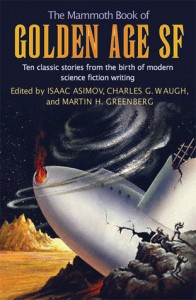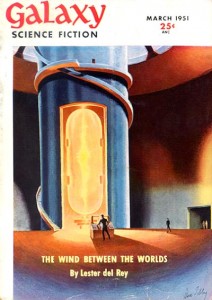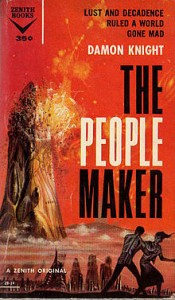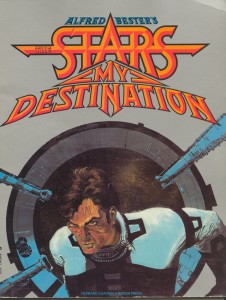“On The Fly” Part One: Reference
(The beginning of a four-part essay on “The Fly”: its social context, the story itself, and its legacy. This may one day become part of something bigger.)
 The two decades that span World War II’s opening salvos to the planting of a human boot on the moon are considered by some the Golden Age of Science Fiction, a period during which the genre gained great traction in popular culture. This traction was not primarily earned through stylistic experimentation or characterization beyond the bare minimum required to tell a particular kind of story, but that in no way impeded the genre’s popularity, and nor should it impede our reading today. Sturgeon’s Law, which dates from this period, states that “ninety percent of everything is crap”. The corollary to this is that the remaining ten per cent might actually be brilliant. Readers of the Golden Age of SF certainly thought so.
The two decades that span World War II’s opening salvos to the planting of a human boot on the moon are considered by some the Golden Age of Science Fiction, a period during which the genre gained great traction in popular culture. This traction was not primarily earned through stylistic experimentation or characterization beyond the bare minimum required to tell a particular kind of story, but that in no way impeded the genre’s popularity, and nor should it impede our reading today. Sturgeon’s Law, which dates from this period, states that “ninety percent of everything is crap”. The corollary to this is that the remaining ten per cent might actually be brilliant. Readers of the Golden Age of SF certainly thought so.
It was only natural, coming out of the ashes of global war, that the very American genre of science fiction benefited from and in some ways took credit for the steady rise in American prosperity. After all, computers, robots, and spacecraft existed in the pages of science fiction before any of them existed in reality. How else could they have come to be? Furthermore, the overlap between the categories of “scientist” and “science fiction writer”—i.e. the possibility that they might occasionally be embodied in the very same person—is captured by such personages as Isaac Asimov and Sir Arthur C. Clarke, the latter famed for popularizing geostationary satellites in a paper in 1945 and later for penning such classics as 2001: A Space Odyssey. (And whose first publication in 1937 was a matter transmitter story called “Travel by Wire!”) With many Golden Age authors striding forth from a background in science or technology, the message was simple:
Some people do more than just dream the future. They get out of bed and build it.
The matter transmitter’s boat was one of many floated by the rising tide of techno-optimism. In the 1950s, some of the biggest names around published stories or novels featuring the device. The list is long, and any attempt to summarize all their tales is doomed to bog down in details, but a select handful further demonstrates the maxim that there is a difference between stories containing a spaceship and stories about a spaceship, and that when you swap out “spaceship” for “matter transmitter” (or “d-mat”) the proportion of about stories rapidly rises.
 The first category of d-mat tale we find in this period is closely related to earlier space opera or planetary romance: humanity engages with the awesome awfulness of outer space by going out and exploring it, or by inadvertently drawing things to us here. In Lloyd Biggle Jr.’s “The Rule of the Door”, Alan E. Nourse’s “The Universe Between”, and Lester del Rey’s “The Wind Between Worlds”, d-mat is the means of engagement between us and extraterrestrial life, either by accident (the use of this technology attracts attention) or by intent (the technology is employed as a test of our natures). Del Rey’s story also features a very different kind of accident, essentially a hole to another world, sucking out our atmosphere and threatening to destroy all life on Earth.
The first category of d-mat tale we find in this period is closely related to earlier space opera or planetary romance: humanity engages with the awesome awfulness of outer space by going out and exploring it, or by inadvertently drawing things to us here. In Lloyd Biggle Jr.’s “The Rule of the Door”, Alan E. Nourse’s “The Universe Between”, and Lester del Rey’s “The Wind Between Worlds”, d-mat is the means of engagement between us and extraterrestrial life, either by accident (the use of this technology attracts attention) or by intent (the technology is employed as a test of our natures). Del Rey’s story also features a very different kind of accident, essentially a hole to another world, sucking out our atmosphere and threatening to destroy all life on Earth.
What appears to be an ordinary spaceship lies at the heart of Poul Anderson’s The Enemy Stars. Realizing that matter transporters will only link the far-flung outposts of an interstellar empire once transceivers are in place at each terminus, metal-and-rivet vessels are sent outwards from Earth bearing the necessary equipment. A story of space exploration is fleshed out by Anderson with intelligent discussions of the technical difficulty of building such machines and the philosophical quandaries faced by anyone who uses them. In a unique twist on two old ideas, the ships are staffed by crews sent to and from Earth by transmitters. When the equipment assigned to one particular crew breaks down, they are rescued by aliens, reaffirming that what lies beyond our world will be constantly surprising.
The second class of stories concerns life back home. Isaac Asimov’s “It’s Such a Beautiful Day” depicts a future where matter-transmitting Doors connect all aspects of the human world—homes, schools, doctors’ surgeries, etc—and no one ever goes outside. In fact, wanting to travel by any other means is considered neurotic, reflecting a contemporary desire for cleanliness and civic safety in the growing middle class. When a Door fails, a young boy is forced to walk to school, compelling him to rediscover a natural world that eventually infects the doctor intending to “cure” him of this new obsession, along with a cold he picked up outside.
This notion of a multiply connected home is taken further in Bob Shaw’s “Aspect”, which features a house whose internal doorways are also matter transmitters, and whose rooms lie on entirely different worlds. (Like Sir Arthur, this was his first published story.) The blurring of boundaries between inside and outside is a frequent feature of this kind of tale, possibly reflecting the slow creep of television into the living room and the blurring of spatial boundaries through the representation of the faraway in the here-and-now.
 In the third class of stories, society as a whole fares badly when introduced to d-mat and related technologies, despite the usual initial optimism accompanying their invention. It is clear, even in the Golden Age, that the love affair with science is on unsteady legs. Attacks on capitalism feature in Ralph (no relation) Williams’ “Business as Usual, During Alterations” and Damon Knight’s “A for Anything”, since along with the ability to copy material objects inevitably comes the total collapse of manufacturing, value, work, purpose . . . Knight was so intrigued, or perhaps alarmed, by the possibilities of this technology that he expanded his original story into a full novel, The People Maker, in which the ability to copy humans as well as objects leads to a culture based on the treatment of individuals as replaceable and therefore disposable: high-tech slavery, in other words.
In the third class of stories, society as a whole fares badly when introduced to d-mat and related technologies, despite the usual initial optimism accompanying their invention. It is clear, even in the Golden Age, that the love affair with science is on unsteady legs. Attacks on capitalism feature in Ralph (no relation) Williams’ “Business as Usual, During Alterations” and Damon Knight’s “A for Anything”, since along with the ability to copy material objects inevitably comes the total collapse of manufacturing, value, work, purpose . . . Knight was so intrigued, or perhaps alarmed, by the possibilities of this technology that he expanded his original story into a full novel, The People Maker, in which the ability to copy humans as well as objects leads to a culture based on the treatment of individuals as replaceable and therefore disposable: high-tech slavery, in other words.
When asked why he chose to explore this particular trope, Knight explained that he did so because he “thought other authors had handled it badly.” Another author drawn to “this matter transmission thing” was Theodore Sturgeon (he of the ninety percent Law). In “Granny Won’t Knit” he depicts what happens when a society that relies on d-mat is threatened by an even more advanced paradigm shift in teleporter technology. No one is safe around matter transmitters, it seems—not even people who already use them. William Temple also dealt with the consequences of copying people, this time a young woman two men are squabbling over, in Four Sided Triangle, which was filmed later that decade (one of many films produced by Hammer Films magnifying social anxieties through the lens of horror). Lloyd Biggle Jr. returned to d-mat in noirish All the Colors of Darkness, capturing the reconfiguration of society at novel length, coupled with a mystery involving the disappearance of two early adopters.
Perhaps the best example of speculation into how widespread teleportation would radically change society is Alfred Bester’s The Stars My Destination. A definitive exception to the rule that science fiction of this period is burdened by wooden prose and cardboard characters, Bester’s classic is considered by some the best SF novel ever written. Gleefully imagining transformation upon transformation, from the vast scales of the solar system right down to the body of a single man, The Stars My Destination is a guide to how we all might fare in the hands of a man who can teleport at will.
 Physical embodiment and transformation has been a recurring motif of the matter transmitter story since its inception, and like their counterparts in previous eras authors during the 1950s frequently focused on death, the ultimate irreversible transformation. With the rate of social and technological change increasing in the real world, it is perhaps unsurprising that we see the dream of an easy exit steadily creeping into these stories, a riff that Barry M. Malzberg would later dub “The Final Trip”. J. T. McIntosh employs d-mat as a suicide machine in “Five into Four”, when a teenager with a death wish erases himself en route to Earth: the four passengers travelling with him are horrified until they learn that they each have absorbed certain psychological qualities from the missing boy, to their lasting benefit. The notion of matter transmission acting as a means of escape with unintended improvement also appears in another Damon Knight story, “Ticket to Anywhere”, in which use of a network of alien teleporters brings the unexpected boon of immortality—a transformation less visible but no less profound than death.
Physical embodiment and transformation has been a recurring motif of the matter transmitter story since its inception, and like their counterparts in previous eras authors during the 1950s frequently focused on death, the ultimate irreversible transformation. With the rate of social and technological change increasing in the real world, it is perhaps unsurprising that we see the dream of an easy exit steadily creeping into these stories, a riff that Barry M. Malzberg would later dub “The Final Trip”. J. T. McIntosh employs d-mat as a suicide machine in “Five into Four”, when a teenager with a death wish erases himself en route to Earth: the four passengers travelling with him are horrified until they learn that they each have absorbed certain psychological qualities from the missing boy, to their lasting benefit. The notion of matter transmission acting as a means of escape with unintended improvement also appears in another Damon Knight story, “Ticket to Anywhere”, in which use of a network of alien teleporters brings the unexpected boon of immortality—a transformation less visible but no less profound than death.
Twisting the tale in a much nastier direction, Eric Frank Russell writes in “U-Turn” of suicide centers offering people an easy way out, only for them to discover too late that the euthanasia booths are actually d-mat booths. The suicides have been coopted against their will to become interstellar colonists, regular volunteers being in short supply because matter transmission is too painful a process to bear. This story also aptly features one of the earliest uses of the perhaps apocryphal Chinese curse “may you live in interesting times”, which certainly applies to the closing months of the 1950s.
The notion that using d-mat might lead to unintended physical consequences is by this time such a cliché that stories exist solely to mock it. Published in 1959, Raymond E. Banks’ “Rabbits to the Moon” echoes Sir Arthur Conan Doyle’s “The Disintegration Machine” (1929) in its depiction of the device as capable of distinguishing between different types of tissue. However, rather than Professor Challenger’s beard, in this instance it is the human skeleton that is left behind when a venal businessman is transmitted, rendering him a hideous blob. Proof that the divestment of impediments like style and characters allowing authors to concentrate on ideas doesn’t always work in a story’s favor, “Rabbits to the Moon” is nonetheless memorable for lampooning an approach that by the 1950s seemed thoroughly overused, along with lounge music and the pork pie hat.
And yet, it is this decade that sees the publication of arguably the most famous single story in the long history of the trope. “The Fly” embraces the body horror of “Rabbits to the Moon” and the structure of “A Man without a Body” (the very first d-mat story, written by Edward Page Mitchell and published in 1877) and makes them relevant all over again. With this story, author George Langelaan singlehandedly transformed the long dreamed-of matter transmitter from something familiar mainly to readers of science fiction and made it into an object of fascination and terror for everyone.
(Next in Part Two: Disintegration)
